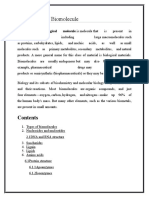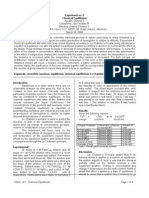Branched Biopolymers: RNA Encode Proteins Eukaryotes Translated
Uploaded by
Shriram ArvinthBranched Biopolymers: RNA Encode Proteins Eukaryotes Translated
Uploaded by
Shriram ArvinthRNA is multifunctional[edit]
RNA is multifunctional, its primary function is to encode proteins, according to the instructions
within a cell’s DNA.[1]:5 They control and regulate many aspects of protein synthesis
in eukaryotes.
RNA encodes genetic information that can be translated into the amino acid sequence of
proteins, as evidenced by the messenger RNA molecules present within every cell, and the RNA
genomes of a large number of viruses. The single-stranded nature of RNA, together with
tendency for rapid breakdown and a lack of repair systems means that RNA is not so well suited
for the long-term storage of genetic information as is DNA.
In addition, RNA is a single-stranded polymer that can, like proteins, fold into a very large
number of three-dimensional structures. Some of these structures provide binding sites for other
molecules and chemically-active centers that can catalyze specific chemical reactions on those
bound molecules. The limited number of different building blocks of RNA (4 nucleotides vs >20
amino acids in proteins), together with their lack of chemical diversity, results in catalytic RNA
(ribozymes) being generally less-effective catalysts than proteins for most biological reactions.
The Major Macromolecule:
Macromolecule Building Block
Bonds that Join them
(Monomer)
(Polymer)
Proteins Amino acids Peptide
Nucleic acids Phoshodiester
Nucleotides (a phoshate, ribose, and
DNA a base- adenine, guanine,thymine, or
cytosine)
Nucleotides (a phoshate, ribose, and
RNA a base- adenine, guanine,thymine, or
cytosine)
Polysaccharides Monosaccharides Glycosidic
unlike the other macromolecules, Some lipids are held together by ester
lipids are not defined by chemical bonds; some are huge aggregates of
Lipids
Structure. Lipids are any organic small molecules held together by
nonpolar molecule. hydrophobic interactions.
Branched biopolymers[edit]
Raspberry ellagitannin, a tannin composed of core of glucose units surrounded by gallic acid esters and
ellagic acid units
Carbohydrate macromolecules (polysaccharides) are formed from polymers
of monosaccharides.[1]:11 Because monosaccharides have multiple functional groups,
polysaccharides can form linear polymers (e.g. cellulose) or complex branched structures
(e.g. glycogen). Polysaccharides perform numerous roles in living organisms, acting as energy
stores (e.g. starch) and as structural components (e.g. chitin in arthropods and fungi). Many
carbohydrates contain modified monosaccharide units that have had functional groups replaced
or removed.
Polyphenols consist of a branched structure of multiple phenolic subunits. They can perform
structural roles (e.g. lignin) as well as roles as secondary metabolites involved
in signalling, pigmentation and defense.
Synthetic macromolecules[edit]
Structure of a polyphenylene dendrimer macromolecule reported by Müllen, et al.[14]
Some examples of macromolecules are synthetic polymers (plastics, synthetic fibers,
and synthetic rubber), graphene, and carbon nanotubes. Polymers may be prepared from
inorganic matter as well as for instance in inorganic polymers and geopolymers. The
incorporation of inorganic elements enables the tunability of properties and/or responsive
behavior as for instance in smart inorganic polymers.
You might also like
- The Structure and Function of MoleculesNo ratings yetThe Structure and Function of Molecules68 pages
- IY486_Molecular Cell Biology _FINAL_ Theme 2 Week 6_Cellular BiomoleculesNo ratings yetIY486_Molecular Cell Biology _FINAL_ Theme 2 Week 6_Cellular Biomolecules32 pages
- The Structure and Function of Macromolecules - Ihb.oktober 2015No ratings yetThe Structure and Function of Macromolecules - Ihb.oktober 2015107 pages
- The Structure and Function of MacromoleculesNo ratings yetThe Structure and Function of Macromolecules106 pages
- DOC-20241225-WA0027._20241225_213313_0000No ratings yetDOC-20241225-WA0027._20241225_213313_000022 pages
- Myoglobin Alpha Helices X-Ray Crystallography Max Perutz Sir John Cowdery Kendrew 1958 Nobel Prize in ChemistryNo ratings yetMyoglobin Alpha Helices X-Ray Crystallography Max Perutz Sir John Cowdery Kendrew 1958 Nobel Prize in Chemistry11 pages
- The Structure and Function of MacromoleculesNo ratings yetThe Structure and Function of Macromolecules105 pages
- HCCS BIOL 1406 Chapter 5 Lecture Notes 10eNo ratings yetHCCS BIOL 1406 Chapter 5 Lecture Notes 10e7 pages
- (Merge) Document (5) - 20241022 - 200933No ratings yet(Merge) Document (5) - 20241022 - 20093325 pages
- Biological Macromolecules the Building Blocks of LifeNo ratings yetBiological Macromolecules the Building Blocks of Life20 pages
- 362853205-BIOMOLECULES-CHEMISTRY-ASSIGNMENTNo ratings yet362853205-BIOMOLECULES-CHEMISTRY-ASSIGNMENT22 pages
- Mathematics and Science Faculty Makassar State University 2013-2014No ratings yetMathematics and Science Faculty Makassar State University 2013-20146 pages
- The Structure and Function of Macromolecules: AP Biology Chapter 5No ratings yetThe Structure and Function of Macromolecules: AP Biology Chapter 548 pages
- Macromolecule Notes Macromolecules: Proteins, Lipids, PolysaccharidesNo ratings yetMacromolecule Notes Macromolecules: Proteins, Lipids, Polysaccharides5 pages
- Macromolecules: Concept 1: Macromolecules Are Polymers, Built From MonomersNo ratings yetMacromolecules: Concept 1: Macromolecules Are Polymers, Built From Monomers8 pages
- 05_Macromolecules use it (3)_988a1b7ab06e86343064a0b3578ed673No ratings yet05_Macromolecules use it (3)_988a1b7ab06e86343064a0b3578ed673118 pages
- Topic THREE - Biological MacromoleculesNo ratings yetTopic THREE - Biological Macromolecules14 pages
- Biological Molecules: Pentoses, Those With Six Carbons As Hexoses, and Those With Seven Carbons As Heptoses. ExamplesNo ratings yetBiological Molecules: Pentoses, Those With Six Carbons As Hexoses, and Those With Seven Carbons As Heptoses. Examples31 pages
- Chapter 5 The Structure and Function of Large Biological MoleculesNo ratings yetChapter 5 The Structure and Function of Large Biological Molecules20 pages
- Anatomy and Physiology for Students: A College Level Study Guide for Life Science and Allied Health MajorsFrom EverandAnatomy and Physiology for Students: A College Level Study Guide for Life Science and Allied Health MajorsNo ratings yet
- Det (A) Det A - A - : Minor Expansion FormulaNo ratings yetDet (A) Det A - A - : Minor Expansion Formula2 pages
- For Other Uses, See .: Polymer (Disambiguation)No ratings yetFor Other Uses, See .: Polymer (Disambiguation)4 pages
- Atomic Structure: How Did The Sub-Atomic Particles Discovered?No ratings yetAtomic Structure: How Did The Sub-Atomic Particles Discovered?56 pages
- Cleaning: Chemical Classification of DetergentsNo ratings yetCleaning: Chemical Classification of Detergents5 pages
- Dha Senior School For Girls Online MOCK-Examinations: There Are FORTY Questions On This Paper. Answer All QuestionsNo ratings yetDha Senior School For Girls Online MOCK-Examinations: There Are FORTY Questions On This Paper. Answer All Questions12 pages
- Describe The Mechanism of Halogenation Reaction in BenzeneNo ratings yetDescribe The Mechanism of Halogenation Reaction in Benzene3 pages
- Role of Phthalic and Glycolic Acids To Increase Chromium Uptake in Leather Tanning ProcessNo ratings yetRole of Phthalic and Glycolic Acids To Increase Chromium Uptake in Leather Tanning Process7 pages
- IGCSE Chemistry Energetics Calculating Molar Enthalpy100% (1)IGCSE Chemistry Energetics Calculating Molar Enthalpy2 pages
- Principles Related To Practical ChemistryNo ratings yetPrinciples Related To Practical Chemistry61 pages
- A Fatal Intoxication Following The Ingestion of 5-Methoxy-N, N-Dimethyltryptamine in An Ayahuasca PreparationNo ratings yetA Fatal Intoxication Following The Ingestion of 5-Methoxy-N, N-Dimethyltryptamine in An Ayahuasca Preparation4 pages
- حليوات و شهيوات - E - قائمة الحلال والحرام من المجموعة... - فيسبوكNo ratings yetحليوات و شهيوات - E - قائمة الحلال والحرام من المجموعة... - فيسبوك2 pages
- Agric Science P1 Grade 11 November Marking Guidelines 2022No ratings yetAgric Science P1 Grade 11 November Marking Guidelines 202211 pages



































































































